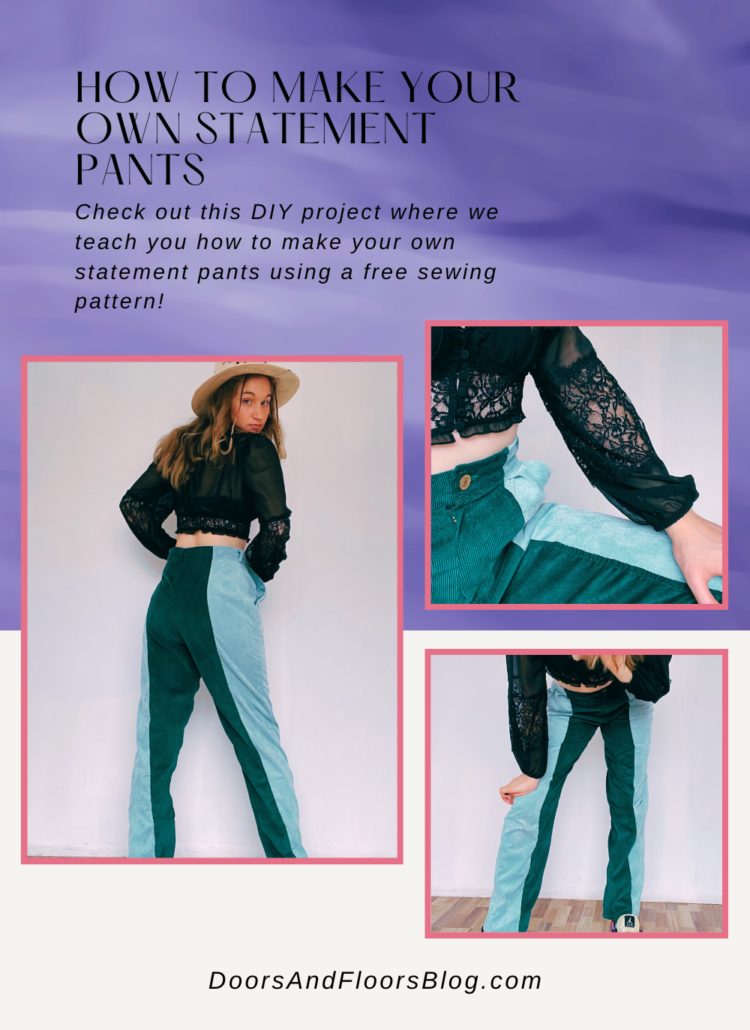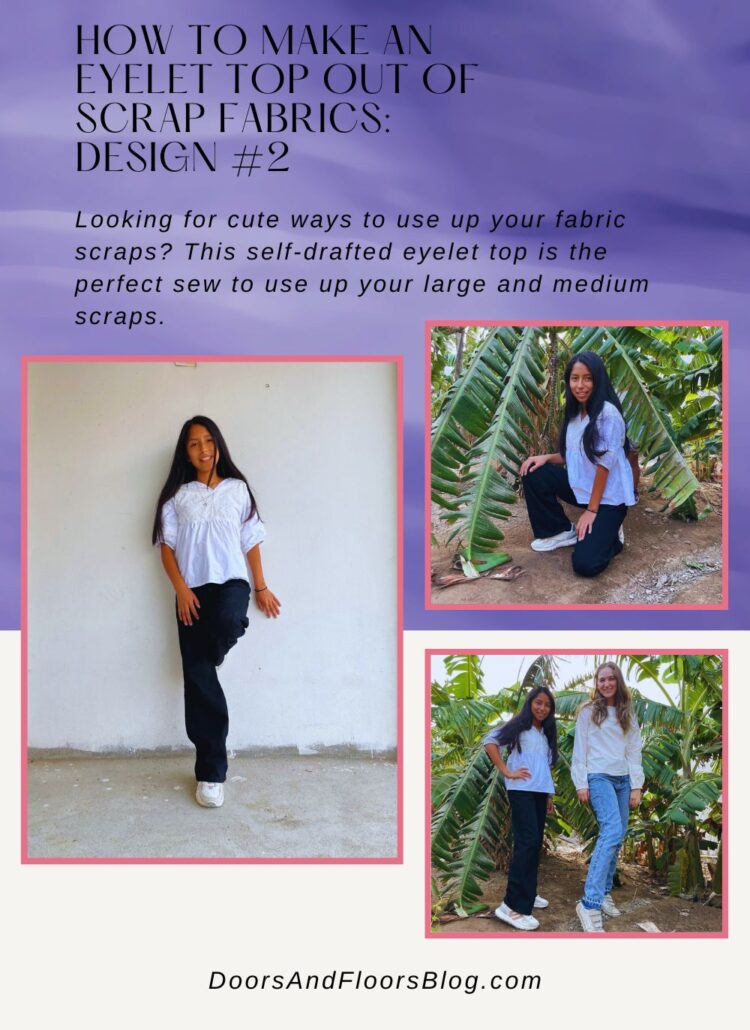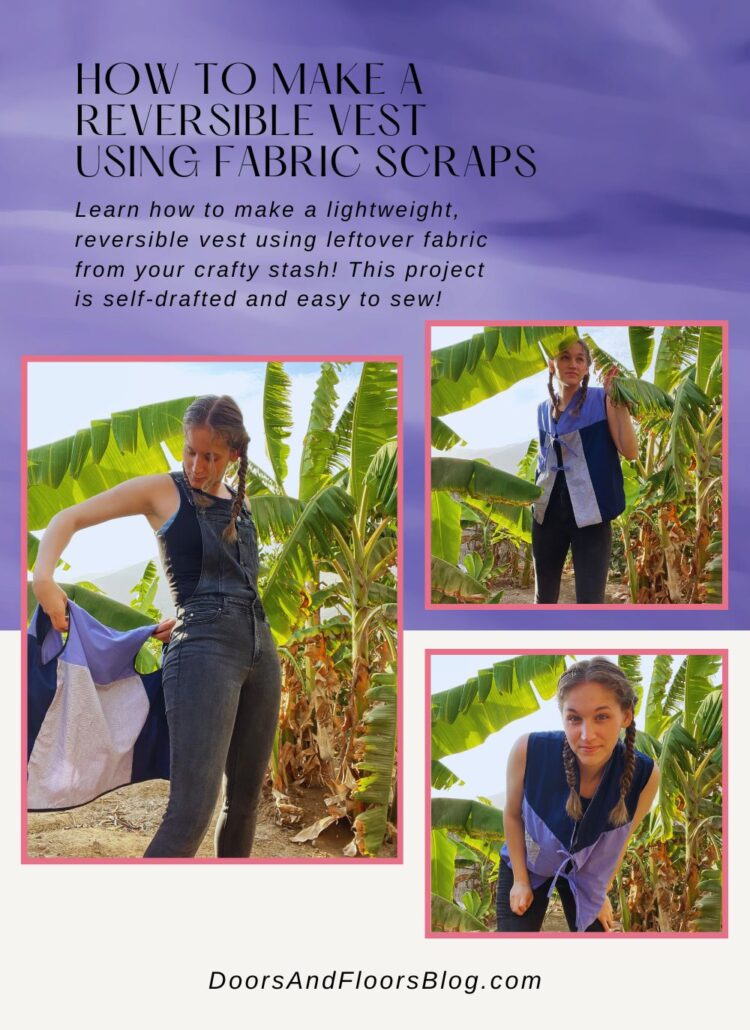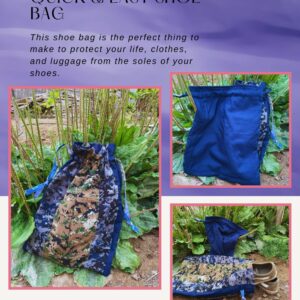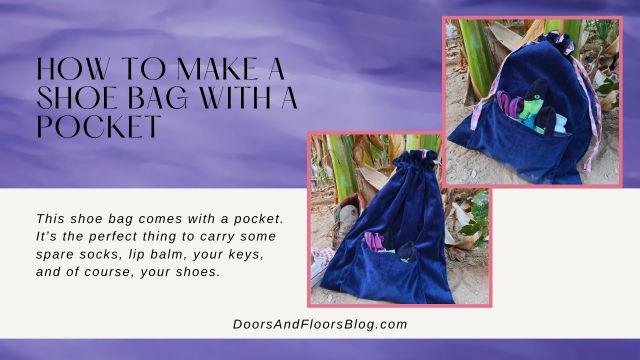
Welcome back! Today we have a bonus sewing post so I can show you how to make a shoe bag with a pocket. This tutorial is almost as easy as the pocket-free shoe bag, only a little more time-consuming. I say “almost as easy,” because sometimes sewing zippers can be difficult.
This shoe bag is the perfect thing to add to your travels. We’re always on the go, from seeing places all over Perú like Sancos, Cusco, and Tingo Maria, to visiting my father-in-law’s farm. Having a second pair of shoes is almost always needed. Today let’s make something super easy, and practical for your next adventure.
Be sure to check out the first Shoe Bag tutorial without a pocket, if that’s more your style.
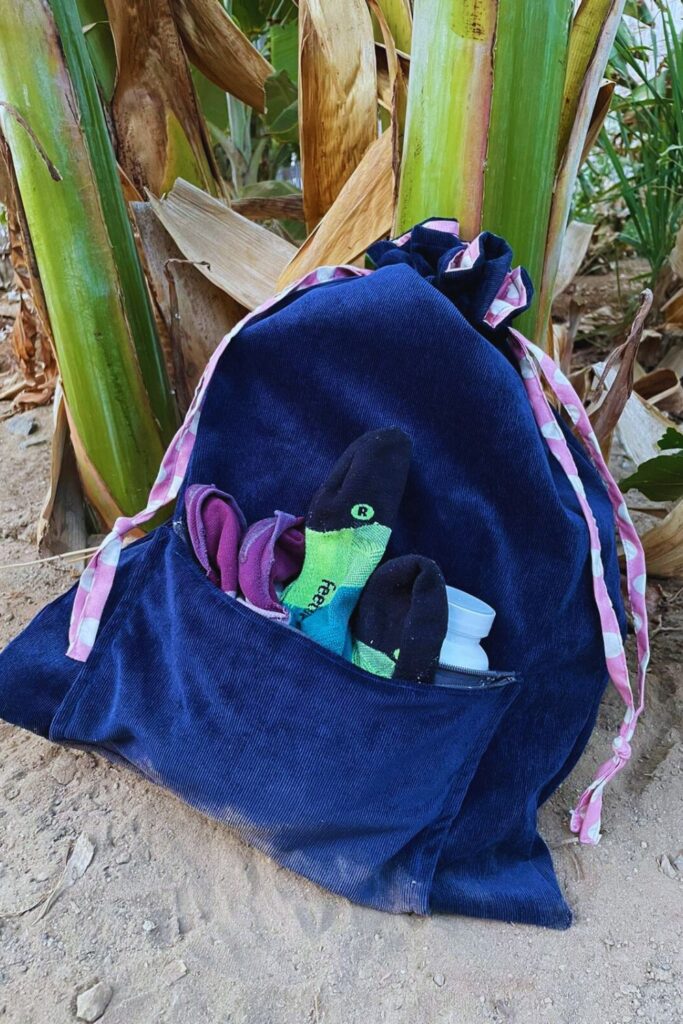
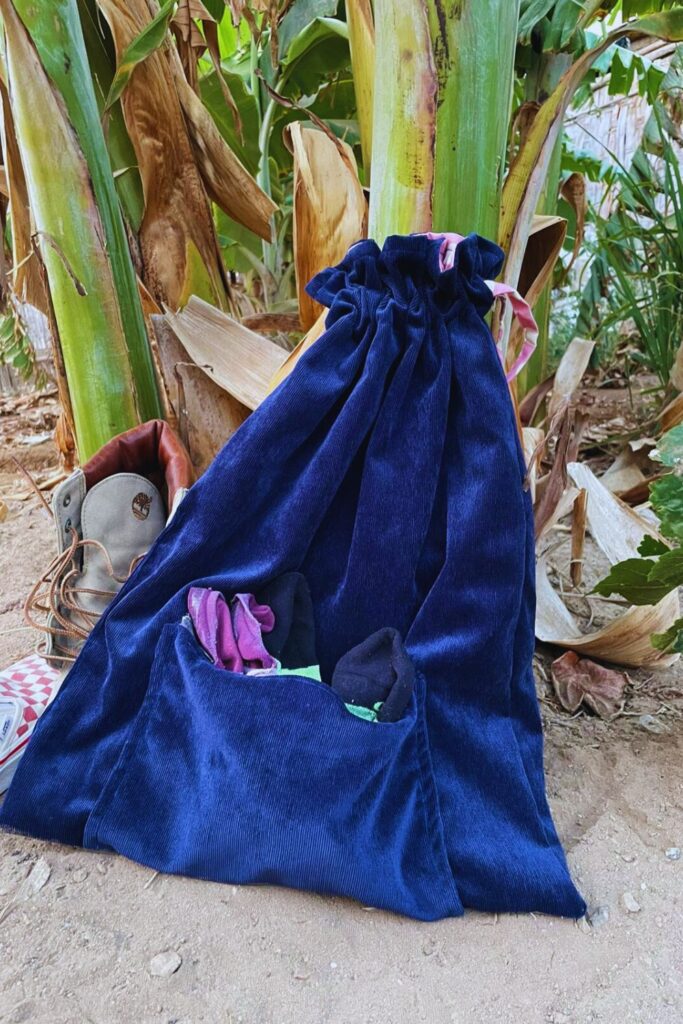
This post may include affiliate links.
Please read my disclaimer page for more info.
*As an Amazon Associate, I earn from qualifying purchases.*
Approximate time put into this project: 2.50 Hours, from cutting to the finished result
What You’ll Need:
- Fabric, maybe .50 a yard if you’re just making one
- A little note on the material used. I used corduroy for the outer shell and a polyester blend for the inside. In the simple Shoe Bag post I used a cotton bedsheet for the inside and outside of one of the bags and a thicker canvas-type material for the outside of the other one.
- I point this out so you’ll consider what type of traveling you’ll do with this bag.
- For plane travel, I recommend lighter materials like cotton or polyester for both the inner and outer shells.
- For road trips, patchworked pieces, canvas, corduroy, etc. are all great options as you usually don’t need to worry about suitcase space the same way. However, I would still do a lighter, cotton or polyester material for the inner lining so it doesn’t get too thick to sew.
- Fabric chalk
- Fabric tape measure and/or ruler
- Sewing machine
- Zipper foot
- A heavy-duty needle if you’re using corduroy, denim or canvas materials
- Matching thread
- Scissors
- Iron and ironing board
- Sewing pins
- A safety pin for feeding the ties through the tunnel in the bag
- 9″ zipper for the pocket
- 1 or 2 Sew-on snaps
Disclaimer: I am trying to teach myself the Metric System, I will always try to include both measurements in my tutorials, i.e. centimeters and inches, meters, and yards. Though I have been using them interchangeably in my everyday sewing life lately, I apologize if I miss including both or switch between the two too often.
Cutting Your Pieces
You’ll need to cut the following pieces of your fabric:
- 1.5″ x 34″ – cut 2 for the ties
- 14″ x 19″ – cut 2 of your lining fabric
- 14″ x 19″ – cut 2 of your outside fabric
- 10″ x 7 ” – cut 2 for the pocket
However, you can make the bag 1″ (3cm) bigger on all sides, if you’re holding something more like boots instead of sneakers. For this project, I cut the following:
- 1.5″ x 35″ – cut 2 for the ties
- 15″ x 20″ – cut 2 of your lining fabric
- 15″ x 20″ – cut 2 of your outside fabric
- 10 x 7″ – cut 2 for the pocket
Sewing Your Pocket

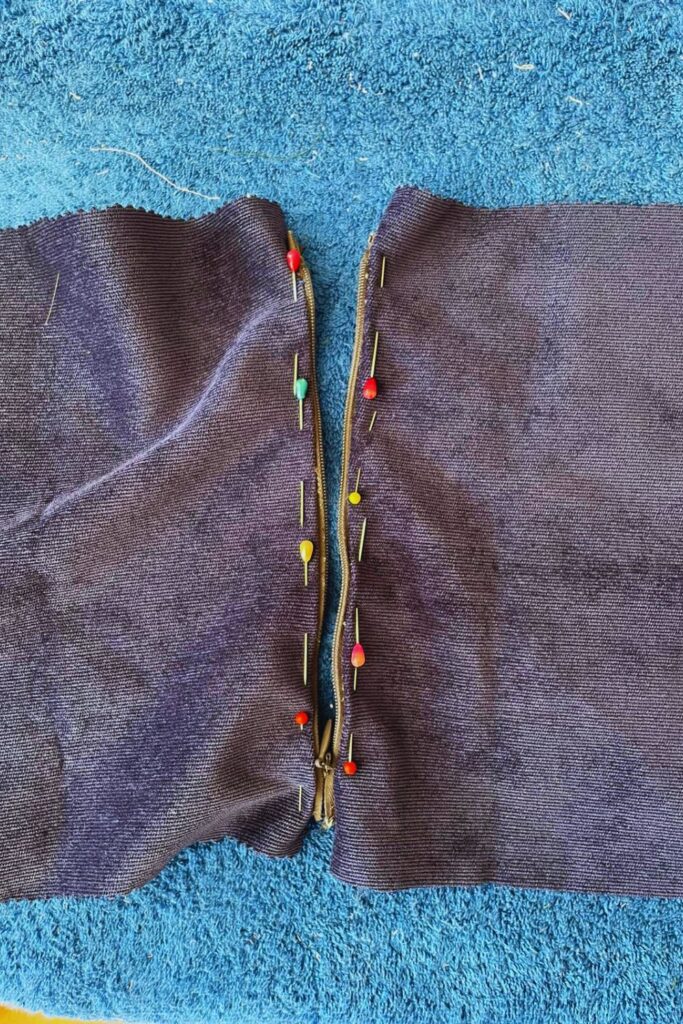
Start by prepping your pocket. Pin the zipper with the good side facing the good sides of both sides of the pocket. Make sure the sides of the pocket line up by testing the zipper before you sew it in place. The zipper should sit at the same spot on both pieces of fabric. Using your zipper foot, sew as close to the zipper as you can get along both sides.
Fold back the fabric and pin it down so you can top stitch along both sides to keep the fabric from getting caught in the zipper.
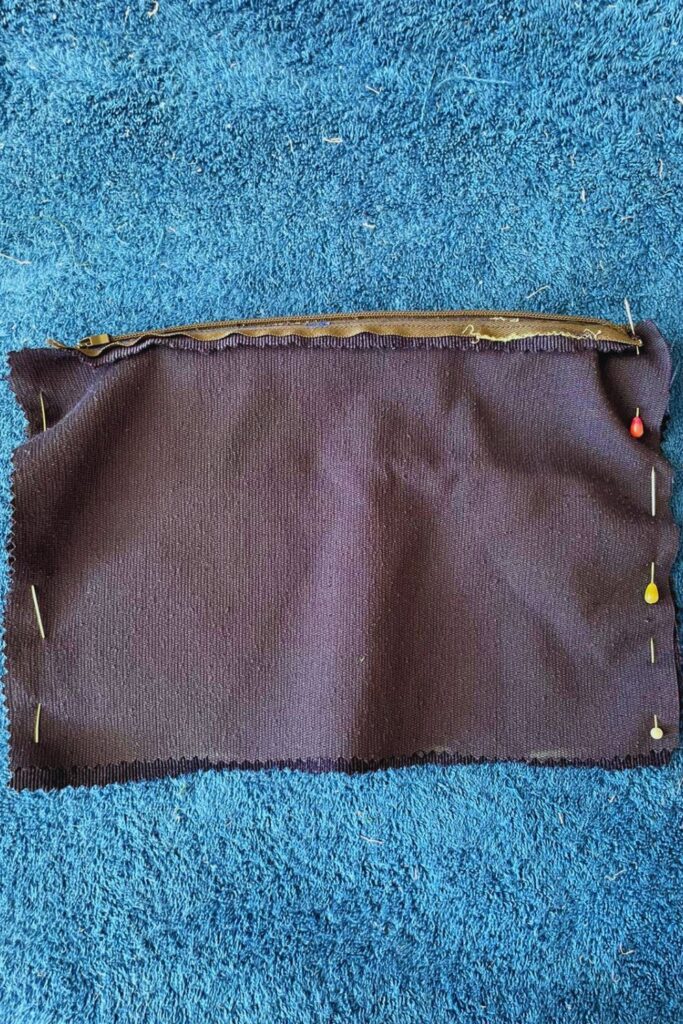
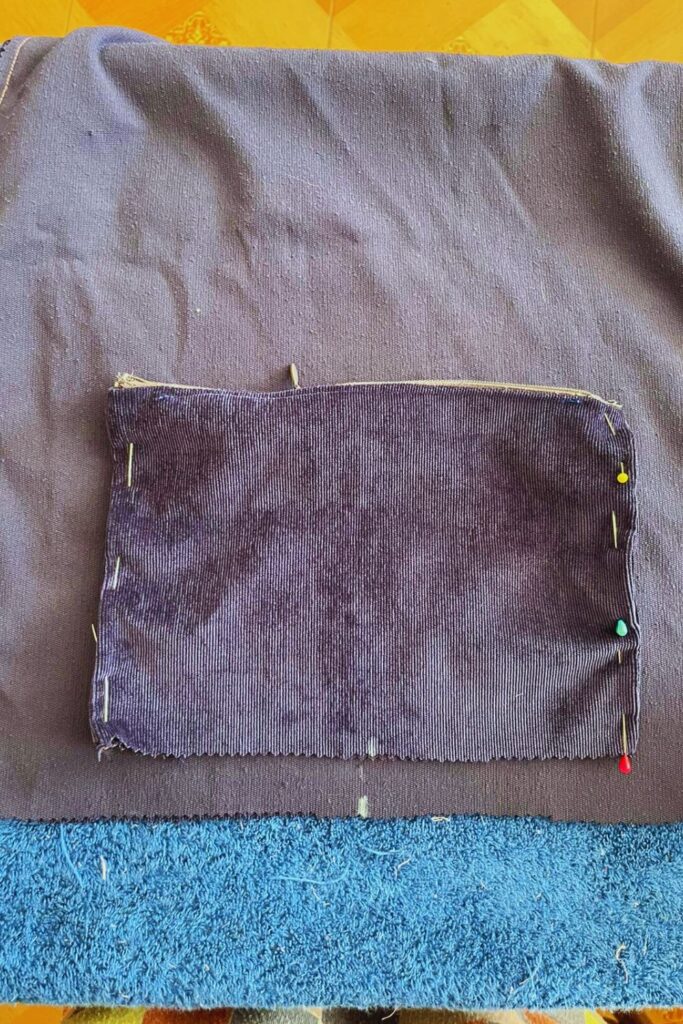
Fold the pocket in half with good sides facing and pin the sides, then sew. Flip the pocket right sides out and pin the sides, sewing a top stitch to hold everything in place. Note, the bottom is still left unsewn.
Find the center bottom of your pocket and mark it with your fabric chalk.
Sewing the Shoe Bag
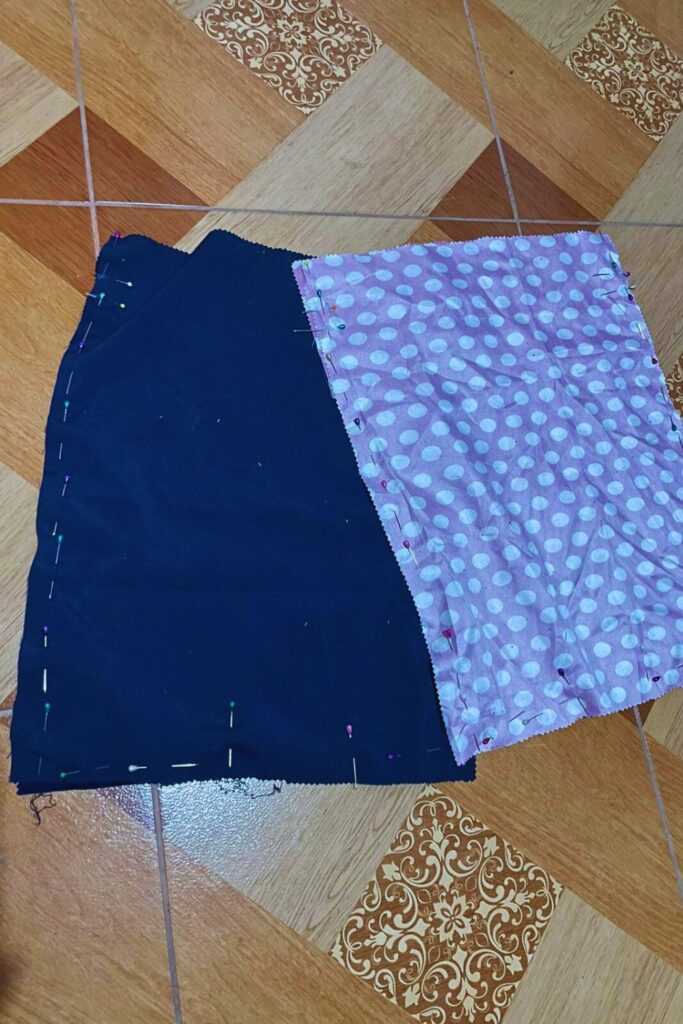
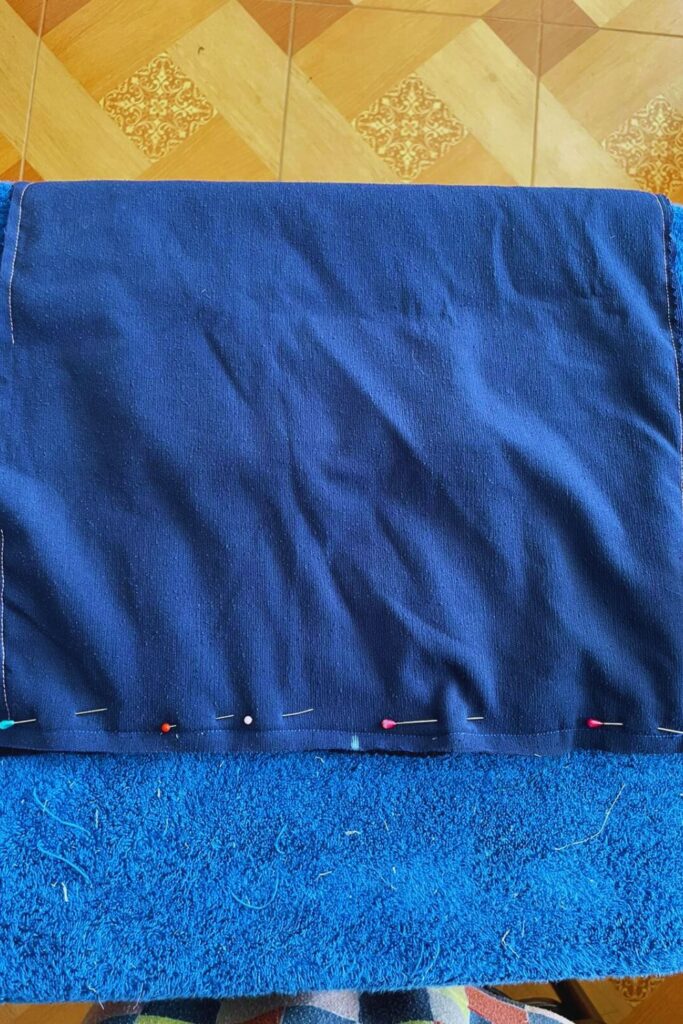
Start by placing the good sides facing of your two lining pieces, doing the same with your two outer pieces. Pin them together along the bottom and both sides. Before you sew anything in place we need to make a few marks for the ties and leave a spot unsewn along the side so we can pull the lining through after we’ve sewn everything together. I left a gap in the same spot on both the lining and outer shell about 4″ (10cm) wide.
Please ignore the placing of my gap in this photo, I moved it to the side after taking the photo.
For the holes for the ties, from the top edge of your lining pieces, measure down 2″ (5cm) and make a mark with your fabric chalk. Next measure down from this mark .75″ (2cm) and make another mark. Repeat this on the other side as well as on the outer shell. I like to add an extra pin directly on the marks I made to ensure I don’t forget and accidentally sew over these lines.
Before you sew everything in place on your outer shell, find the center at the bottom of the bag and make a mark with your fabric chalk. Grab your pocket and line up the mark on the bottom of the pocket with the mark on the bottom of your bag. Pin everything in place, sandwiching the raw edge of the pocket in between the bag.
Now sew up the sides and the bottom of the outer shell and lining pieces. Make sure not to sew over the gap we marked at the top and leave an extra, larger gap in the side toward the bottom.
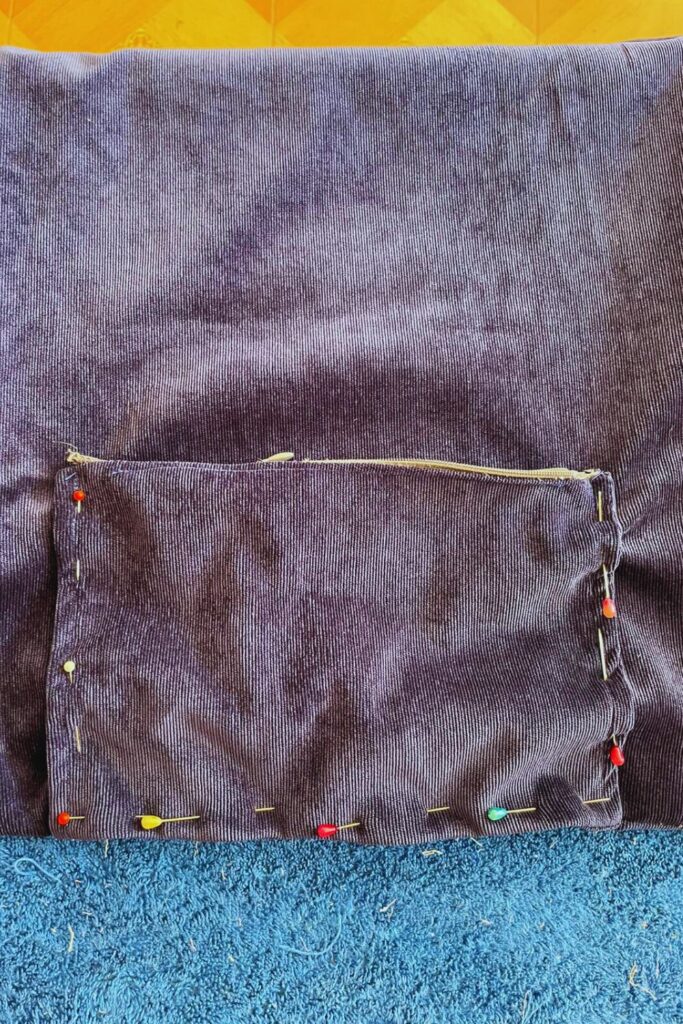

Turn the outer bag right sides out and pin the pocket in place. You’ll need to sew a top stitch around both sides and the bottom so it doesn’t flop around.
I really recommend switching to a heavy-duty needle if your outer fabric is corduroy, canvas, or denim. Top stitching this pocket in place is very thick and could easily break a needle.
Before you sew the lining and outer shell together, find the center of your pocket and mark it with a pin. Then grab a sewing needle and a snap and sew one side to the back of the pocket and the other to the shoe bag. This will keep the outer pocket from falling down and helps keep your inner pocket contents secure.
For more security, consider sewing two snaps instead of one at the center.

Nestle the outer shell inside the lining so that the good sides are facing and pin around the top edge. Sewing to connect the two and make your shoe bag.

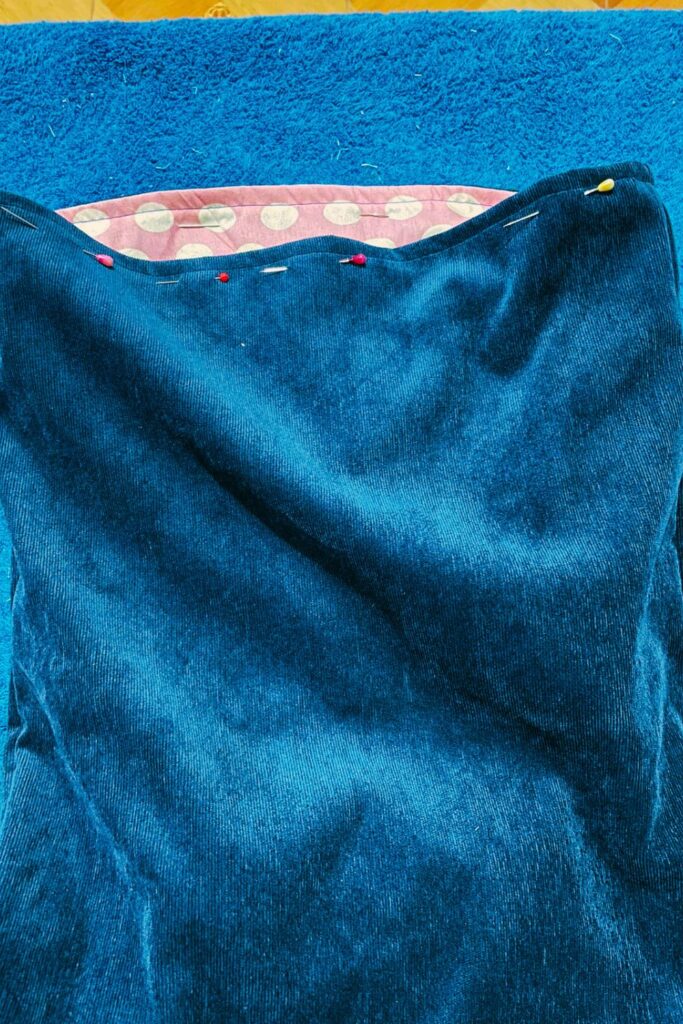
Once it’s sewn together, pull both bags through the holes you left in the side so that everything has the right sides facing out. Remember to pull the corners out so they sit nicely. Pin both gaps closed in the lining and the shell, top stitching to close the hole.
Nestle the lining inside the outer shell and pin along the top edge so that the lining and the outer shell don’t move, then sew a straight stitch around the top edge of the shoe bag.
Sewing the Ties
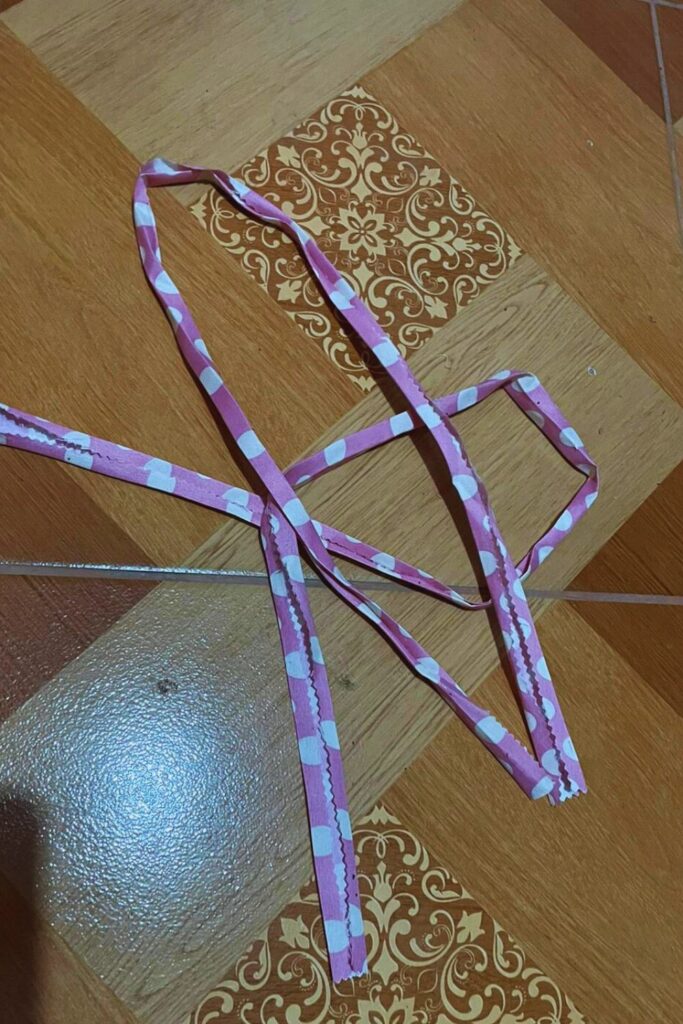

To prepare the ties for the shoe bag, iron each strip by folding them in half with the wrong sides facing. Then fold the two raw edges inside and give it a press. Finally, fold the strip of fabric closed, concealing the raw edges inside. Take the ties to your sewing machine and sew along the raw edge. I recommend folding the raw edge at the end of the strap to the inside before you sew it in place, doing the same for the other end when you reach it. You can also use something like a bias tape maker for this if you prefer.
Flip your shoe bag inside out. Grab your fabric chalk and a ruler and draw two straight lines on either side of the holes we left for the ties. Drawing all the way around until you complete both circles. I used the pins in the photo on the right to keep the shell and lining from sliding apart while sewing.
Sew a straight stitch around the bag following the lines drawn, creating a tunnel to feed the ties through later.
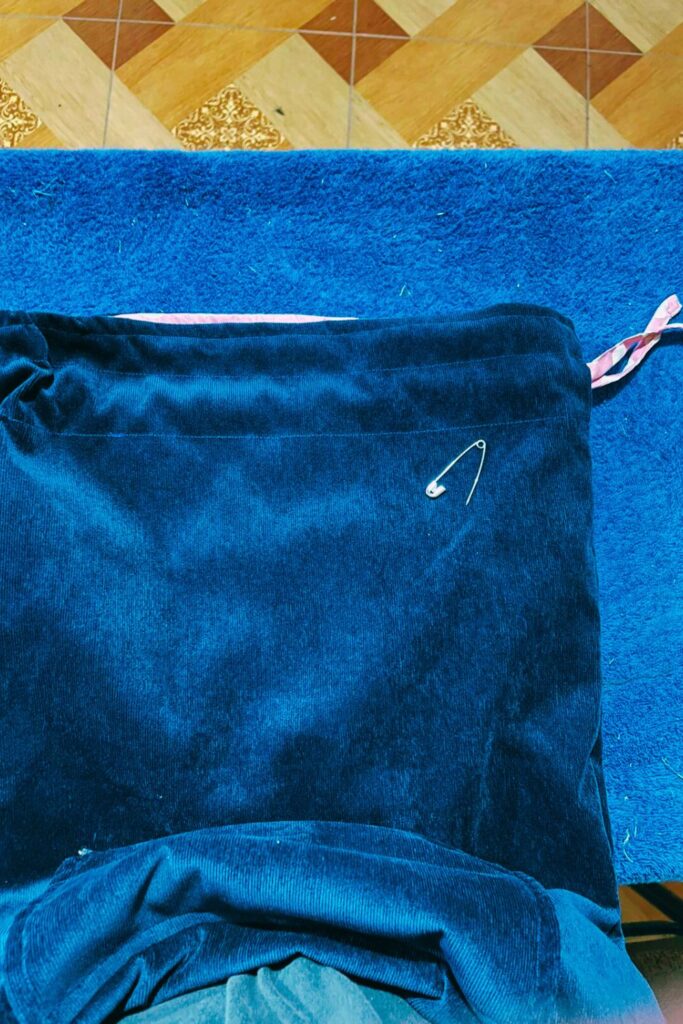
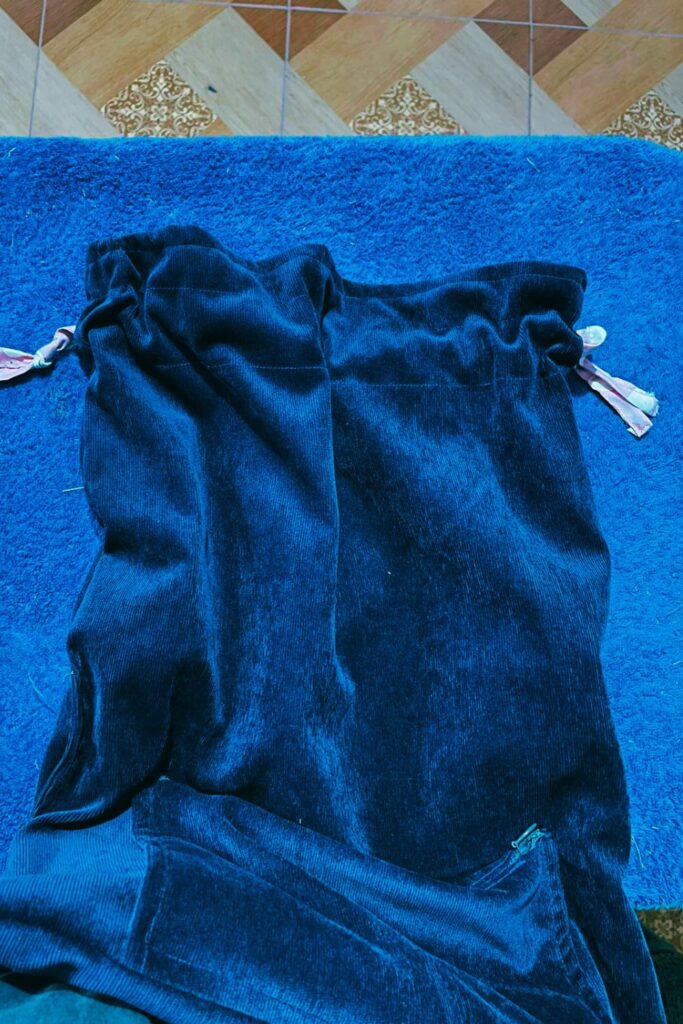
Attach a safety pin to the end of one of the ties and feed the first one through the tunnel. One will go in one side, around the back and front, and back out the same hole it entered. The other tie will enter the other side, go around the front and back, and exit the first hole it entered. Finally tie a knot on each side with the two ends, ensuring the ties don’t get lost in the bag.
Finished Results

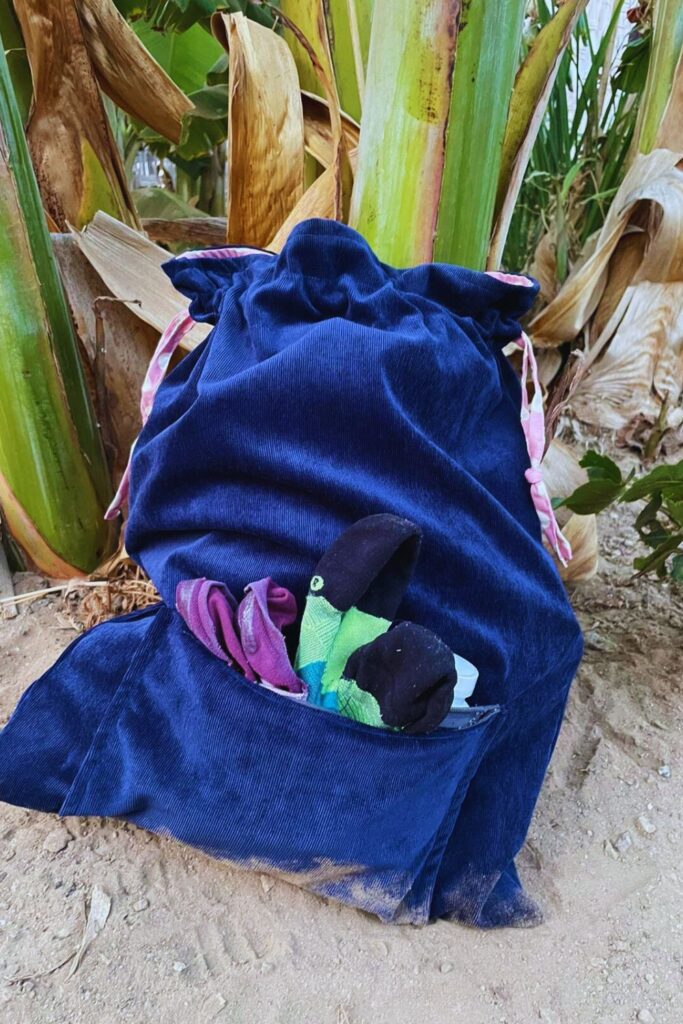
Here is the shoe bag with a pocket. What do you think? Do you lean more toward this one or the pocket-free shoe bag? I like to keep my favorite socks in the pocket, because you never know when you might need an extra pair. The bag can easily be thrown in the washing machine when dirty, though I do recommend brushing off any mud or dirt.
In the picture on the right, I was able to put a pair of boots and a slip-on shoe. They didn’t fit perfectly together because it’s not really meant to carry two at a time. But I wanted to see what possibilities there were, in a pinch, it’s totally doable.
If you decide to give this project a go, tag me on Instagram @doorsandfloorsblog and use the hashtag #DoorsAndFloorsBlog so I can see what you make! Let me know in the comments which shoe bag you prefer!
Explore other recent posts:
- Remote Work Life in Perú: Introducing The Chickens
- How To Make A Kids Scrap Fabric Top: Design #3
- The Truth About Working Remotely In Perú
- How To Make An Eyelet Top Out Of Scrap Fabrics: Design #2
- 10 Interesting Restaurant Culture Shocks From Eating Out In Perú

Find us on social media!
P.S. Looking for a fun activity you can do with a friend while working on tedious crafty tasks, download our free trivia here.
Playing trivia is a great way to keep your mind active and have fun with your crafty friends and family while busting out those seam ripping, crocheting, and other time-consuming, but necessary, crafty tasks.

